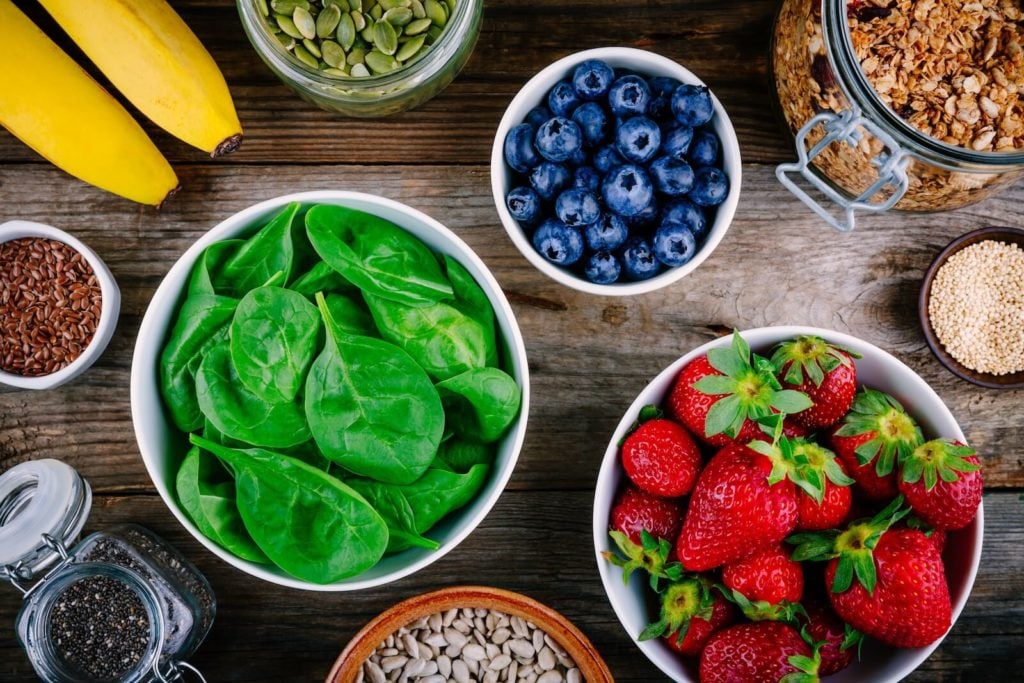Are Meal Replacement Shakes Good For You?
How, Why, and When to Choose Meal Replacement Shakes
- What Defines a 'Meal Replacement Shake'?|
- Who Might Use a Meal Replacement Shake?|
- Benefits of Meal Replacements|
- What to Look for In a Meal Shake|
- Elemental Diets Versus Meal Replacement Shakes|
- Recap|
- Meal replacement shakes have traditionally been about weight loss but can also be useful when your digestive system needs a bit of a break.
- They also work as a healthy breakfast or to refuel and replenish muscles after hard exercise.
- Meal replacement shakes have been shown to support healthy blood sugar and insulin sensitivity.
- Look for meal replacement shakes that are low in added sugars, contain healthy fats and proteins, and are made with whole food ingredients.
- Make sure to choose a meal replacement shake free from ingredients that you’re intolerant of (such as dairy or gluten).
For really stubborn gut problems, an elemental diet is likely the better choice.
Eating a balanced, healthy diet can sometimes be a challenge, especially when you have the constraints of a hectic work schedule, travel, or gut sensitivities that make specific foods out of bounds.
This is where meal replacement shakes can be a help. A well-formulated complete meal replacement will provide balanced nutrition to fill the gap when you can’t or don’t want to cook, and can be a gentler alternative to chewing or processing solid foods when gut symptoms flare. Good quality meal replacements are also low in allergens and other possible food triggers, providing a useful rest for those with sensitive digestive systems.
The latest science supports the use of meal replacement shakes, especially in areas such as weight management and metabolic health. In this article, we’ll take a look at the when, what, and how of meal replacements so you know the best way to benefit from their use.

What Defines a ‘Meal Replacement Shake‘?
“Meal replacement” is the term used to describe a product (usually powdered, but sometimes a ready-to-drink shake) that replaces someone’s normal meal [1]. Typically, you’ll add water, cow’s milk, or a plant-based milk if you are dairy-free.
You can also vary things up by adding fruit, Greek yogurt, or nut butter (for example, organic peanut butter), to your own taste.
Meal replacement shakes are regulated differently in different countries, but in the U.S. are typically considered conventional foods. This means meal replacement products must:
- Comply with all regulatory requirements for food
- List every ingredient and a full Nutrition Facts panel
This isn’t, however, a guarantee of high-quality nutrition. You may have to do your research and read the labels on meal replacement shakes carefully.
For example, you might want to check that the product gives you a good balance of carbs, proteins, and fats for your individual needs and doesn’t contain any allergens or ingredients you might be sensitive to. Some meal replacements may provide quality whole foods ingredients, while others can have more synthetic ingredients.
Who Might Use a Meal Replacement Shake?

There are several reasons you might want to use meal replacement shakes. These include general wellness and more specific health reasons:
Healthy nutrition on the go. Getting a healthy meal that isn’t loaded with additives, sugars and refined carbs can be difficult when traveling. A meal replacement shake is a much healthier option than grabbing fast food or food from a gas station.
Easier on the digestive system. For people who have gut issues or sensitivity to particular foods, a liquid (low allergen) shake is often easier to digest and assimilate than solid food.
Blood sugar control. Those who struggle with blood sugar or have pre-diabetes or other metabolic risk factors (such as high blood pressure or high cholesterol) may find meal replacements useful.
An easy breakfast. A meal replacement powder made into a drink is a good choice if you can’t face food early in the morning.
A post-workout snack. A high-protein meal replacement shake can be a convenient way to refuel and repair muscles after exercise. This is especially the case if it’s a while until your next scheduled full meal.
Portion control. A low-calorie meal replacement shake that replaces a couple of your daily meals can help you lose weight or be an effective part of a healthy weight management diet.
Benefits of Meal Replacements

A balanced diet of whole foods is the ideal, but when this isn’t possible, a high-quality meal replacement with transparent manufacturing processes and high-quality ingredients may actually improve your health.
Some of the benefits of meal replacements that have been documented include the following.
Blood Sugar & Metabolic Health Benefits
- A 2018 randomized controlled trial (RCT) with 162 overweight/obese adults found that 16 weeks of using high-protein meal replacements as part of a calorie-controlled diet improved [2]:
- Cholesterol
- Triglycerides
- Insulin
- C-reactive protein (an inflammatory marker)
- Blood glucose
- Blood pressure
- Another 2018 RCT of Type-2 diabetes patients found that full, or partial replacement of meals with shakes for 12 weeks improved hemoglobin A1c (a measure of average blood sugar over the past 2-3 months), fasting blood sugar, blood pressure, and weight [3].
- A diabetes-specific nutritional shake for breakfast and as an afternoon snack also improved blood sugar control and reduced cravings for starchy foods [4].
Weight Loss
- When dieters using meal replacement shakes were compared with dieters on other diets (and both groups received standard levels of support), the meal replacement groups lost 5 lbs more on average, per year [5].
- If meal replacement users received a higher level of psychological and practical support, the difference in weight loss was even higher — they lost 13.5 lbs more than standard dieters given standard support [5].
- Twelve weeks of meal replacement shakes also curbed food cravings by 20% [6].
Improved Nutrient Intake
- In one study, those who used replacement meal shakes ate fewer calories, less fat, and more protein, fiber, calcium, magnesium, iron, zinc, copper, vitamin E, vitamin C, thiamin, niacin, vitamin B6, and folate [7].
- In another review, researchers looked for adverse effects of meal replacements, including whether they caused nutritional deficiencies. Two studies reported no health/medical issues with the shakes, while five more found that they actually improved the nutritional quality of the participants’ diets [5].
What to Look For in a Meal Shake

As with your normal diet, good quality ingredients, and a healthy nutritional balance are what you should be looking for when you choose a meal replacement.
For people who still struggle from time to time with inflammation and gut sensitivities, I’d recommend these general pointers to help you choose a meal replacement shake:
Reduced or Low Carb
Though some people can cope with higher carb diets very well, many others can’t. If you have a gut imbalance, fermentable carbohydrates often create gas, bloating, and diarrhea symptoms, so it’s better to steer clear of them in large amounts [8].
In fact, finding your ideal intake of carbohydrates and prebiotics is one of the four pillars of healthy eating for gut healing that I focus on in Healthy Gut, Healthy You.

Low Allergen
Depending on your individual sensitivities, you’ll need to choose a meal replacement shake that won’t upset your gut. To be on the safer side you may want to choose one that is free from common allergens — i.e. lactose-free, and dairy-free, soy-free, and gluten-free.
Good Quality Protein
Higher protein diets may help manage your weight and control blood pressure and levels of triglycerides in the blood [9]. Depending on your preferences and/or sensitivities, you may want to look into different protein sources.
For example, pea protein is a neutral-tasting vegan protein that works well in a meal shake. It also avoids the use of whey protein, which isn’t suitable for those with dairy intolerance.
Research has found pea protein to help with appetite suppression, improved muscle health, and lower cholesterol and blood pressure [10, 11].
Free From Artificial Sweeteners
I generally advise people with gut problems to avoid artificial sweeteners. The research isn’t conclusive in this area, but several animal studies show links between saccharin, aspartame, and sucralose and alterations in gut bacteria. Artificial sweeteners have also been linked with an uptick in intestinal and liver inflammation [12, 13, 14, 15].
Whole Food Focused
In some meal shakes, the ingredients are highly processed or synthetically produced. However, the best meal replacement shakes provide naturally sourced antioxidants and essential vitamins, from whole superfood ingredients like berries and greens.
Healthy Fats
Good fat is an essential part of any diet, including if you use meal shakes. Good fats include omega-3 — linked with better heart health [16] — and medium-chain triglycerides (MCTs). MCTs appear to improve cognitive function in some groups [17, 18] and have been linked with small improvements in body weight and composition (muscle/fat ratio) [19, 20]. They are also thought to potentially reduce insulin resistance [21, 22].
Elemental Diets Versus Meal Replacement Shakes
As well as standard meal replacement shakes, you may have also come across elemental diets, which are another form of meal shake. So which is best for you?
What’s an Elemental Diet?
An elemental diet supplies all of your essential vitamins and macronutrients (proteins, carbs, and fats), but in a pre-digested form that is very easy for your digestive system to deal with. So, for example, instead of protein, an elemental shake will contain its constituent amino acids.
Elemental diets were first developed for patients with severe digestive issues [23, 24]. But over time, other useful applications of the elemental diet — even if used on an ad hoc basis — have been discovered.
For example, You may benefit from an elemental diet if:
- You suffer from a stubborn gut imbalance. Research shows that the elemental diet can be helpful for IBD (Crohn’s disease and colitis) [25, 26], SIBO [27], IBS [27], and celiac disease [28]. Using an elemental diet for a week or two may start to turn things around when other gut therapies have failed.
- You’re having an inflammatory flare. An elemental diet can also be very helpful to quickly relieve inflammation if your gut condition flares. Even a “half” elemental diet (up to 50% of daily calories from elemental shakes) for a time may reduce gut symptoms and flares [29].
How Elemental and Meal Replacement Shakes Compare
Like elemental diets, meal replacement shakes also provide proteins, carbohydrates, fats, and essential vitamins and minerals (such as vitamin C potassium and iron). But the nutrients are not pre-digested in the same way.
While a meal replacement shake can be easier to digest than a solid meal, it may not be as effective when it comes to healing an extremely sensitive or inflamed gut.
In short:
- If you’re having an acute symptomatic flare or need a complete gut reset: Choose an elemental formula if you are having an acute clinical flare in symptoms or need a complete gut reset.
- A meal replacement shake is a good choice if you have some ongoing gut issues but have already made some headway in the gut healing process.
- A meal replacement shake can be a good transition product between moving from a completely elemental diet to a completely solid one.
Meal Replacement Shakes: A Recap
When you need healthy, convenient nutrition on the run or that won’t upset a sensitive gut, a quality meal replacement shake is a good option. Replacing breakfast and/or lunch is the most usual practice, with a balanced meal making up your third meal of the day.
Meal replacement shakes aren’t a panacea for digestive issues and should be part of a wider gut-healing plan, for example, the one described in Healthy Gut, Healthy You.
Some people with stubborn gut issues or other symptoms will benefit from more thorough investigations. If you are interested in a personal consultation, contact us at the Ruscio Institute.
The Ruscio Institute has developed a range of high-quality formulations to help our patients and audience. If you’re interested in learning more about these products, please click here. Note that there are many other options available, and we encourage you to research which products may be right for you.
Dr. Michael Ruscio is a DC, natural health provider, researcher, and clinician. He serves as an Adjunct Professor at the University of Bridgeport and has published numerous papers in scientific journals as well as the book Healthy Gut, Healthy You. He also founded the Ruscio Institute of Functional Health, where he helps patients with a wide range of GI conditions and serves as the Head of Research.
Discussion
I care about answering your questions and sharing my knowledge with you. Leave a comment or connect with me on social media asking any health question you may have and I just might incorporate it into our next listener questions podcast episode just for you!